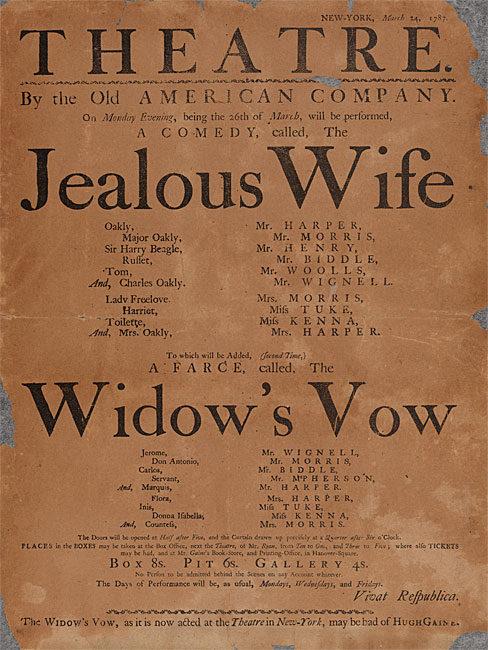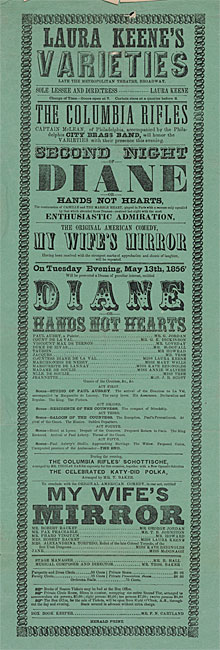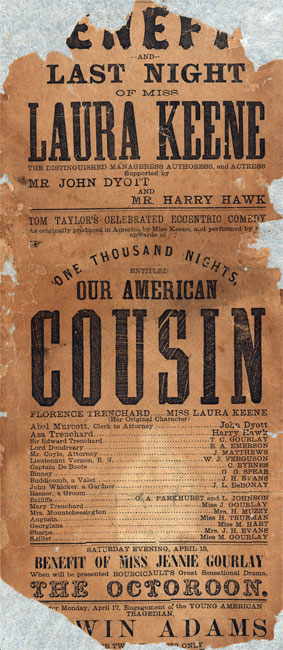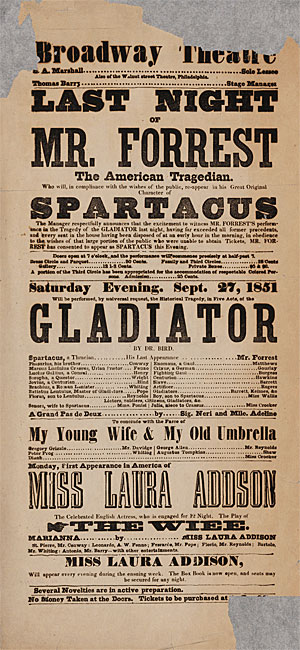Theatrical Broadsides
Tuesday, June 18, 2019 by
The Museum’s Collection of Theatrical Broadsides contains approximately 700 playbill advertisements. Over 300 broadsides announcing eighteenth and nineteenth century New York theatrical performances are now available on the Collections Portal, and more will be added as conservation, digitization and cataloging are completed. By listing the productions, performers, theaters, admission costs and broadside printers, these objects provide diverse scholarly perspective on New York City.
The John Street Theatre was the first permanent playhouse in New York City, built by actor and manager David Douglass in 1767. At the time, it was simply referred to as the Theatre. The John Street Theatre survived the American Revolutionary War, although performances were on hiatus from 1774 because the Continental Congress banned theater entirely. Theatrical productions returned to New York in 1785. This broadside announces a comedy and a farce for Monday evening, March 26, 1787.
As the population of New York City grew, so did the demand for theater, and competition among theater owners increased as well. Audiences were lured by broadsides advertising creature comforts such as ladies’ withdrawing rooms, gentlemen’s saloons, refreshments and ventilation. One can imagine the appeal of escaping a hot and humid night in the city by slipping into Wallack’s Lyceum Theatre – “Summer having driven into New York, in her glowing car, on tonight and every night during the heated term, the celebrated Indian punkas will be brought into play, and diffuse through the theater a soft and refreshing breeze.”
Laura Keene (1826-1873) was born in England and pursued a career as an actress, after her husband was sent to prison and she was left to care for their two children alone. She debuted on the London stage in 1851, and accepted an offer from James William Wallack to join his theater company in New York City in 1852. She would eventually become a theater manager in 1855, taking over the Metropolitan Theatre and renaming it Laura Keene’s Varieties.
In addition to being manager, she directed plays and continued to perform in them. One year later, she opened Laura Keene’s Theatre on Broadway between Houston and Bleecker Streets. In 1858, the play “Our American Cousin” premiered in New York at her theater and achieved much acclaim. Keene’s theater company performed “Our American Cousin” on the road. This broadside announces the production attended by President Abraham Lincoln when he was fatally shot by the actor John Wilkes Booth at Ford’s Theatre in Washington, D.C. on April 17, 1865.
Several broadsides document the admittance of people of color and racial segregation in theaters. They can be searched on the Collections Portal with the subject term “Segregation in theaters.” This broadside from the Broadway Theatre, located at 326 Broadway, notes that the price of admission to the “colored gallery” is 25 cents. It is from the year 1847, the same year the theater was built.
This broadside, also from the Broadway Theatre at 326 Broadway, is from the year 1851 and announces, “A portion of the third circle has been appropriated for the accommodation of respectable colored persons, admission 25 cents.”
These broadsides provide an opportunity to investigate and interpret the entertainments afforded to some eighteenth and nineteenth century Americans. Preserving Performance Past: Conservation and Digitization of the Museum of the City of New York’s Collection of Theatrical Broadsides has been made possible in part by a major grant from the National Endowment for the Humanities: Exploring the human endeavor.







